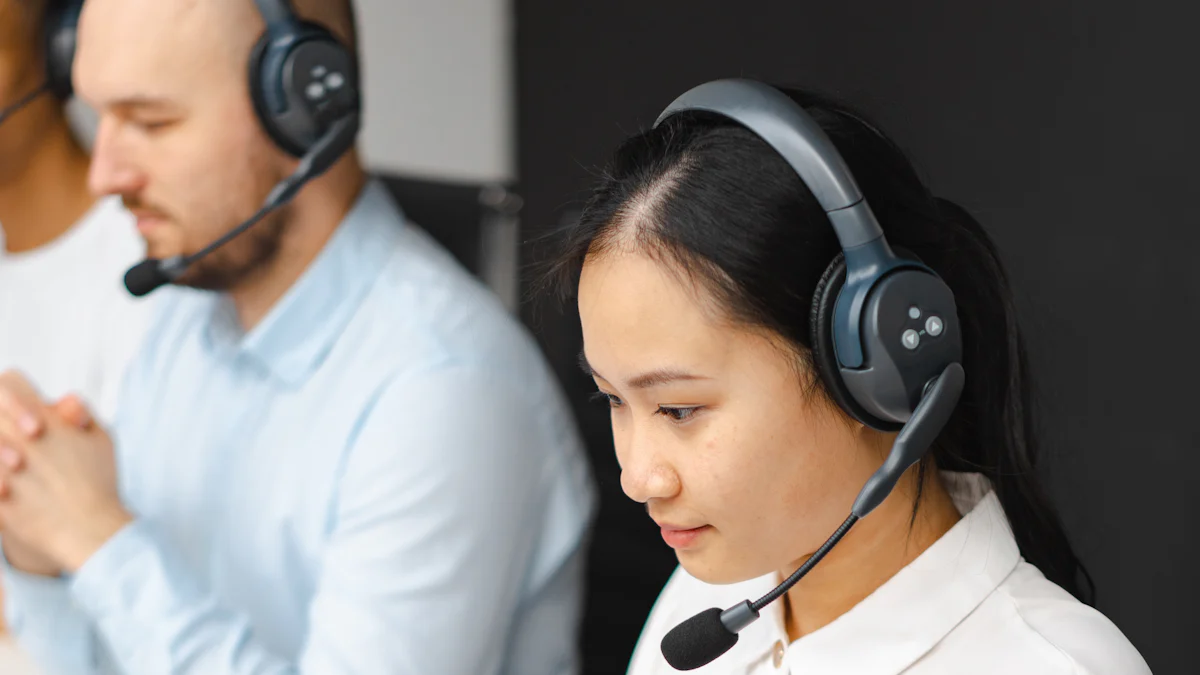Choosing the Best Noise-Canceling Headsets for Office Calls

In today's bustling office environments, noise-canceling headsets have become essential tools for maintaining focus and productivity. These headsets not only block out distracting background noise but also enhance audio quality, allowing you to hear every detail clearly during calls or while listening to music. By incorporating a headset with noise-cancelling microphone designed for clear calls in open offices, you ensure that your communication remains crisp and uninterrupted. This clarity is crucial for effective collaboration and decision-making, making noise-canceling headsets a practical investment for any professional setting.
Understanding Noise-Canceling Technologies

Noise-canceling technologies have revolutionized how you experience sound in busy environments. By understanding the different types of noise cancellation, you can choose the best headset for your needs.
Passive Noise Cancellation
Passive Noise Cancelling relies on the physical design of the headphones to block out noise. The ear cups create a seal around your ears, which reduces external noise. This type of noise cancellation is effective for high-frequency sounds like chatter or office equipment. You don't need batteries or power for passive noise cancelling, making it a simple and reliable option.
Active Noise Cancellation
Active Noise Cancelling headphones use advanced technology to reduce unwanted noise. They have microphones that pick up external sounds. The headphones then produce sound waves that are the exact opposite of the noise, effectively canceling it out. This type of noise cancellation works well for low-frequency sounds like air conditioning or traffic. Active noise cancelling headphones require power, usually from a battery, to function. They provide a more immersive listening experience by significantly reducing ambient noise.
Adaptive Noise Cancellation
Adaptive noise cancellation takes active noise cancelling a step further. It adjusts the level of noise cancellation based on your environment. If you're in a quiet room, the headphones reduce the noise cancellation to save battery. In a noisy setting, they increase the noise cancellation to block out more sound. This type of noise cancellation offers flexibility and efficiency, ensuring you get the best sound quality wherever you are. Adaptive noise cancelling is ideal for those who move between different environments throughout the day.
Understanding these technologies helps you make an informed decision. Whether you prefer passive noise cancelling for its simplicity or active noise cancelling for its effectiveness, knowing the type of noise cancellation that suits your lifestyle is key. Adaptive noise cancelling provides a balance, adapting to your surroundings for optimal performance.
How Noise Cancelling Headphones Work
Noise Cancelling headphones work by using technology to reduce unwanted sounds. They create a quiet environment for you, even in noisy places. Understanding how these headphones function can help you appreciate their benefits of noise cancelling.
-
Microphones Capture Sound: Noise Cancelling headphones have small microphones on the outside. These microphones listen to the sounds around you. They pick up noises like traffic, chatter, or air conditioning.
-
Sound Waves Analyzed: The headphones analyze the captured sound waves. They identify the frequency and amplitude of the noise. This analysis helps in creating an opposite sound wave.
-
Opposite Sound Waves Created: The headphones generate sound waves that are the exact opposite of the unwanted noise. This process is called destructive interference. When these opposite waves meet the noise, they cancel each other out.
-
Silence Achieved: As a result, you experience silence or reduced noise. The headphones allow you to focus on your music or calls without distractions. This feature is especially useful in busy environments.
-
Adaptive Adjustments: Some advanced models offer adaptive noise cancelling. They adjust the level of noise cancellation based on your surroundings. If the environment becomes quieter, the headphones reduce the noise cancelling to save battery. In noisier settings, they increase the cancelling effect.
Noise Cancelling headphones work effectively to enhance your listening experience. By understanding their operation, you can make informed choices about which model suits your needs. Whether you need them for work or leisure, these headphones provide a peaceful audio experience.
Criteria for Choosing the Right Headset
When buying noise cancelling headphones, you need to consider several factors to ensure you make the best choice for your office calls. Each criterion plays a crucial role in determining the overall performance and suitability of the headset for your specific needs.
Type of Noise Cancellation
Understanding the type of noise cancellation is essential. Various Experts in audio technology explain that noise-cancelling headsets use two main techniques: Active Noise Cancellation (ANC) and Passive Noise Isolation. ANC headphones have tiny microphones on the outer housing that listen to surrounding noise. They then create an artificial sonic mirror image of that external sound, effectively canceling it out. This process, known as antiphase, results in silence or near silence, allowing you to focus on your calls without distractions. On the other hand, passive noise isolation relies on the physical design of the headphones to block out noise, which can be effective for high-frequency sounds like office chatter.
Budget Considerations
Remember, investing in a quality headset can enhance your communication experience, making it a worthwhile expenditure for professionals who frequently engage in office calls.
Battery Life
Battery life is another critical factor to consider. Active noise cancelling headphones require power to function, usually from a built-in battery. You should look for models that offer long battery life to avoid frequent charging, especially if you have long workdays or back-to-back meetings. Some advanced models also feature adaptive adjustments, which help conserve battery by reducing noise cancellation in quieter environments. This feature ensures that your headset remains operational throughout the day, providing uninterrupted service during important calls.
By considering these criteria, you can make an informed decision when buying noise cancelling headphones. Whether you prioritize noise cancellation type, budget, or battery life, understanding these aspects will help you select a headset that meets your needs and enhances your office communication.
Comfort and Fit
When selecting noise-canceling headsets, comfort and fit play a crucial role in your overall experience. You wear these headsets for extended periods during office calls, so they must feel comfortable. Look for headsets with adjustable headbands and cushioned ear cups. These features ensure a snug fit without causing discomfort or pressure on your ears.
Various Experts in audio technology emphasize the importance of ergonomic design. They suggest that headsets with lightweight materials and breathable padding enhance comfort. This design prevents fatigue, allowing you to focus on your tasks without distractions. Additionally, consider the size and shape of the ear cups. Over-ear models provide better noise isolation and comfort compared to on-ear designs.
Privacy Features
Privacy features in noise-canceling headsets ensure that your conversations remain confidential. In busy office environments, you need headsets that prevent sound leakage. This feature ensures that others cannot overhear your calls. Look for models with tight seals around the ear cups. These seals block sound from escaping, maintaining your privacy.
Some headsets offer advanced privacy features like mute buttons and retractable boom microphones. These features give you control over your audio input, allowing you to mute your microphone when needed. This control is essential during sensitive discussions or when you need to step away from your desk.
By prioritizing comfort, fit, and privacy features, you can choose a noise-canceling headset that meets your needs. These aspects enhance your communication experience, ensuring that you remain comfortable and your conversations stay private.
Recommendations for Specific Headsets

Choosing the right noise-canceling headphones for office calls involves understanding your specific needs and preferences. Here, you'll find recommendations that cater to various requirements, ensuring you make an informed decision.
Wired vs Wireless Options
When deciding between a wired headset and a wireless headset, consider your work environment and mobility needs. A wired headset offers a stable connection without the need for charging. This option suits those who remain stationary during calls. On the other hand, a wireless headset provides freedom of movement, allowing you to walk around while on a call. Wireless office headsets are ideal for multitaskers who need flexibility.
Key Considerations:
- Wired Headset: Reliable connection, no battery concerns.
- Wireless Headset: Mobility, requires charging.
Multi-Device Compatibility
In today's interconnected world, multi-device compatibility is crucial. You might need to switch between your computer, phone, and tablet seamlessly. Headset compatibility guides can help you choose models that support multiple devices. For instance, the Sony WH-1000XM4 offers Bluetooth multipoint, allowing you to connect to two devices simultaneously. This feature ensures you never miss a call, regardless of the device you're using.
Benefits:
- Seamless Switching: Connect to multiple devices without hassle.
- Enhanced Productivity: Stay connected across platforms.
Top Picks for Different Needs
Different users have varying needs when it comes to noise-canceling headphones. Here are some top picks based on specific requirements:
-
Best for Budget: The Sony WH-CH720N stands out for its all-round appeal at an affordable price. It offers decent noise cancellation and sound quality, making it a great choice for budget-conscious buyers.
-
Best for Noise Cancellation: The Bose QuietComfort Ultra provides top-tier noise cancellation with adjustable ANC levels. It's perfect for those who prioritize a quiet environment during calls.
-
Best for Features: The Sony WH-1000XM5 excels in smart features like auto-pause and Bluetooth multipoint. It offers excellent noise canceling and is suitable for tech-savvy users who value convenience.
-
Best for Battery Life: If long battery life is your priority, consider the Bose models, known for their superior battery performance. They ensure your headphones last through extended workdays.
By considering these options, you can select headphones that align with your specific needs, enhancing your office communication experience.
Call Center Headsets
When you work in a call center, choosing the right headset becomes crucial for effective communication. Call center headsets are designed to provide clear audio and minimize distractions, ensuring that you can focus on your conversations. These headsets often feature advanced noise-canceling technology, which is essential in a bustling call center environment.
-
Jabra Evolve Series: Jabra offers a range of headsets specifically designed for call centers. The Jabra Evolve series provides excellent noise cancellation, allowing you to hear and be heard clearly. These headsets come with comfortable ear cushions and adjustable headbands, making them ideal for long hours of use.
-
Poly Savi Series: Poly, formerly known as Plantronics, is another popular choice for call center headsets. The Poly Savi series offers wireless options that provide freedom of movement while maintaining a stable connection. These headsets feature noise-canceling microphones, ensuring that your voice comes through clearly even in noisy environments.
-
Sony WH-CH720N: While not specifically marketed as call center headsets, the Sony WH-CH720N offers great all-round appeal at an affordable price. They provide decent noise cancellation and sound quality, making them a viable option for those on a budget.
When you shop call center headsets, consider factors such as comfort, noise cancellation, and connectivity. Wired options offer reliability, while wireless models provide flexibility. By choosing the right headset, you enhance your productivity and communication in the call center.
Headset with Noise-Cancelling Microphone Designed for Clear Calls in Open Offices
In open office environments, maintaining clear communication can be challenging due to background noise. A headset with noise-cancelling microphone designed for clear calls in open offices becomes essential. These headsets ensure that your voice is heard clearly, minimizing distractions from surrounding sounds.
-
Jabra Engage 50: This headset is specifically designed for open office settings. It features a noise-canceling microphone that filters out background noise, ensuring that your calls remain clear. The Jabra Engage 50 also offers a comfortable fit, making it suitable for extended use.
-
Poly Voyager Series: Poly's Voyager series provides headsets with noise-cancelling microphones that excel in open office environments. These headsets offer seamless connectivity and superior audio quality, allowing you to focus on your calls without interruptions.
-
Bose QuietComfort Ultra: Known for its top-tier noise cancellation, the Bose QuietComfort Ultra is an excellent choice for open offices. It provides adjustable ANC levels, allowing you to customize the noise cancellation based on your surroundings.
When selecting a headset with noise-cancelling microphone designed for clear calls in open offices, prioritize features like comfort, connectivity, and noise cancellation. These aspects ensure that you can communicate effectively, even in a noisy environment.
Choosing the right noise-canceling headset for office calls involves understanding your specific needs and preferences. Consider factors like noise cancellation type, budget, battery life, comfort, and privacy features. These elements ensure you select a headset that enhances your communication experience.
"Interviewing your users will provide insights into their lives, experiences, thoughts, and mindsets," which can guide your decision-making process.
Investing in a quality headset not only improves call clarity but also boosts productivity and focus. Prioritize your requirements and make an informed choice to enjoy seamless and effective communication in your professional environment.
See Also
Selecting The Ideal 360-Degree Camera For Your Meetings
Finding The Top Webcam For Huddle Room Use
Discovering The Best Video Conferencing Camera For Meetings
